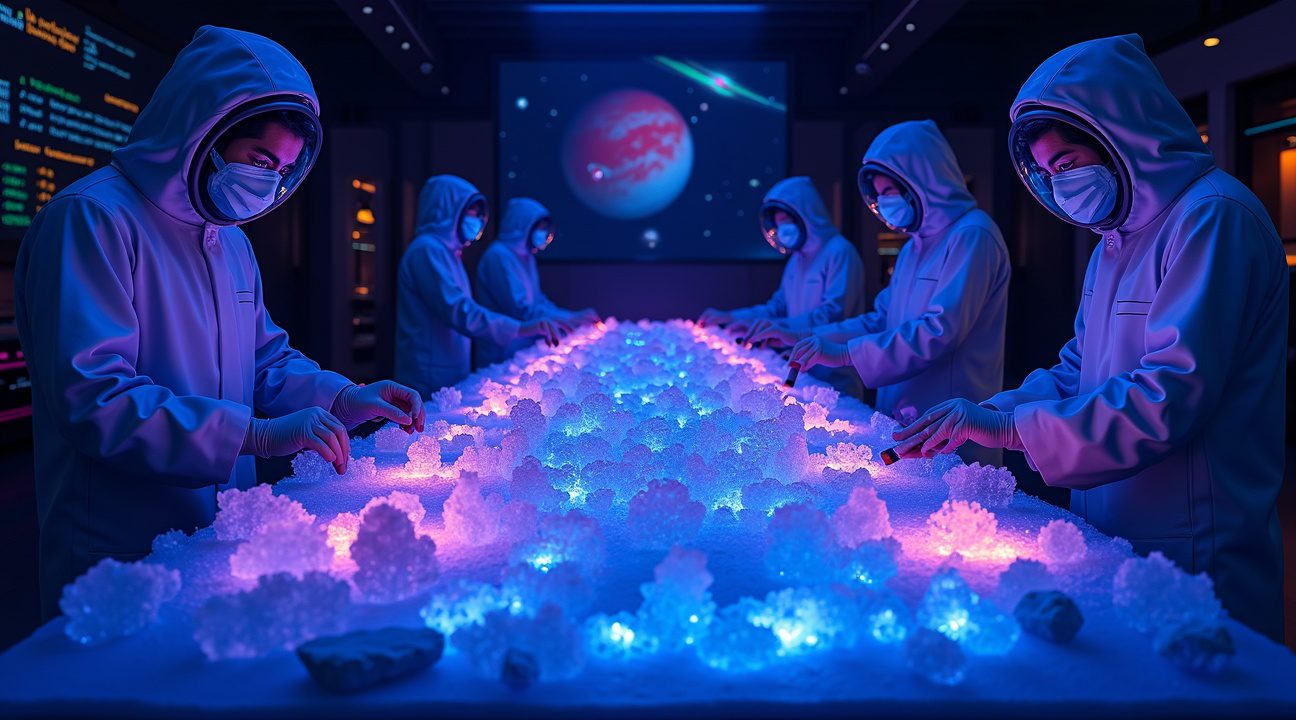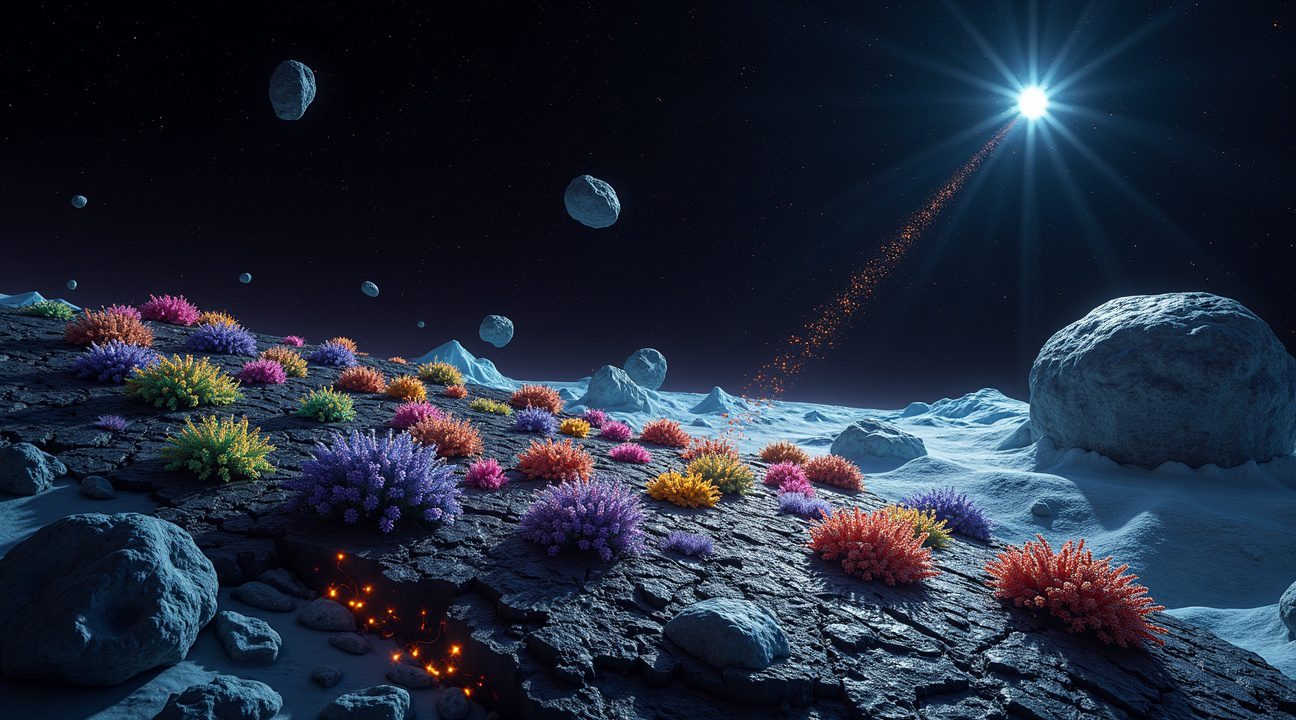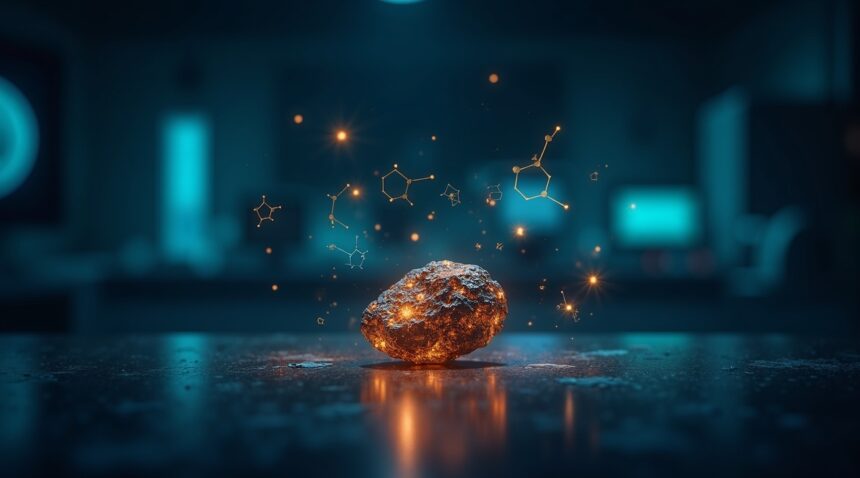Scientists have made a remarkable discovery by detecting all five nucleobases essential for DNA and RNA in meteorite samples, marking the culmination of a decades-long quest to identify these critical building blocks of life in space-derived materials.
Key Takeaways
- All five canonical nucleobases—adenine, guanine, cytosine, thymine, and uracil—have now been found in carbonaceous chondrite meteorites. This includes the first-ever detection of cytosine and thymine in extraterrestrial sources.
- Ultra-sensitive analytical techniques capable of detecting organic molecules at parts per trillion were instrumental in this discovery, surpassing previous methods that could not identify such low concentrations.
- Laboratory simulations confirm that nucleobases can naturally form via photochemical reactions triggered by cosmic radiation acting on simple molecules, indicating these processes are likely common across space.
- Sample-return missions such as OSIRIS-REx are critical, as they provide uncontaminated extraterrestrial samples, enabling more accurate studies of prebiotic chemistry in space environments.
- This finding lends strong support to the panspermia hypothesis, which proposes that the ingredients for life were transported to Earth and possibly other planets via meteorites, potentially catalyzing the beginning of biological systems.
All Five Genetic Building Blocks Now Detected in Space Rocks Using Ultra-Sensitive Technology
Scientists have achieved a breakthrough that fundamentally changes our understanding of life’s potential origins. All five canonical nucleobases essential for DNA and RNA have now been conclusively identified in meteorite samples, completing a decades-long search for these critical building blocks of life in extraterrestrial materials.
The complete set includes both purines and pyrimidines—the two fundamental categories of nucleobases. Purines encompass adenine and guanine, while pyrimidines consist of cytosine, thymine, and uracil. This discovery marks the first time that cytosine and thymine, previously elusive components, have been definitively detected in space rocks.
Carbonaceous chondrites, particularly the famous Murchison and Murray meteorites, served as the primary sources for these groundbreaking findings. These ancient space rocks, which formed over 4.5 billion years ago, have long been treasured by researchers for their rich organic content. However, detecting the complete suite of nucleobases required technological advances that weren’t available during earlier investigations.
Revolutionary Detection Methods Reveal Hidden Organic Treasures
The breakthrough came through ultra-sensitive mass spectrometry techniques capable of detecting organic molecules at parts per trillion (ppt) levels. This represents a massive improvement in analytical sensitivity compared to previous methods. Such precision allows researchers to identify trace amounts of nucleobases that would have been completely invisible to earlier detection systems.
Scientists catalogued over 30 types of nitrogen heterocyclic compounds during their analysis, extending far beyond the five canonical nucleobases. This extensive inventory includes numerous structural isomers that share similar molecular formulas but differ in atomic arrangement. Key examples include:
- Isocytosine, which mirrors cytosine’s molecular composition but with altered atomic positioning
- Imidazole-4-carboxylic acid, representing another variant within this chemical family
- 6-methyluracil, demonstrating the diversity of uracil-related compounds present in meteorites
These additional compounds provide crucial context for understanding how nucleobases might form naturally in space environments. The presence of multiple isomers suggests that various chemical pathways can produce these life-essential molecules under extraterrestrial conditions.
The implications extend beyond simple detection. Finding all five nucleobases together strengthens the hypothesis that life’s chemical foundations could emerge spontaneously throughout the universe. This discovery supports theories about panspermia—the idea that life’s ingredients might travel between worlds aboard meteorites and comets.
Previous studies had successfully identified adenine and guanine in meteorites, but cytosine and thymine remained frustratingly absent from confirmed detections. Their discovery required not only improved technology but also refined extraction and purification methods that could isolate these delicate molecules without contamination from Earth-based sources.
The presence of these nucleobases in carbonaceous chondrites suggests they formed through natural chemical processes in space, possibly within the parent asteroids before Earth’s formation. This timing implies that the chemical precursors for DNA formation existed in our solar system from its earliest days.
Understanding how these molecules survive the harsh journey through space and atmospheric entry provides insights into life’s potential resilience across cosmic distances. The successful preservation of all five nucleobases in meteorites demonstrates that complex organic chemistry can persist under extreme conditions, opening possibilities for similar processes throughout the galaxy.
This comprehensive detection represents more than just a scientific milestone—it fundamentally reshapes our perspective on life’s cosmic context. With all essential genetic building blocks now confirmed in space rocks, researchers can better explore how life might emerge naturally across the universe, using chemistry that appears surprisingly common in our cosmic neighborhood.
Extraterrestrial Delivery May Have Jump-Started Life on Early Earth
I find the discovery of all five DNA and RNA bases in meteorites provides compelling evidence that space-borne objects delivered the essential building blocks of life to our planet billions of years ago. These organic compounds – adenine, guanine, cytosine, thymine, and uracil – form the genetic alphabet that makes heredity and evolution possible. When scientists detected these nucleobases in pristine extraterrestrial samples, they strengthened the case for panspermia, the theory that life’s fundamental components originated beyond Earth.
The OSIRIS-REx mission represents a breakthrough in this field of research. This spacecraft collected samples directly from asteroid Bennu, ensuring minimal risk of terrestrial contamination that has plagued previous meteorite studies. Unlike meteorites that crash through Earth’s atmosphere and potentially pick up biological contaminants, these samples remained sealed in space-grade containers throughout their journey back to our planet.
Asteroid Bennu Reveals Prebiotic Chemistry in Action
Analyses of Bennu’s pristine material revealed far more than just nucleobases. Scientists discovered amino acids, essential minerals, and water-bearing compounds within the asteroid’s structure. These findings suggest that complex organic molecules can form and persist in the harsh environment of space.
The presence of water and specific minerals on Bennu creates ideal conditions for in situ synthesis of organic compounds. I recognize this environment as particularly significant because it demonstrates how asteroids can function as natural laboratories where prebiotic chemistry unfolds over millions of years. Water acts as a solvent, allowing chemical reactions to proceed more efficiently, while minerals serve as catalysts that accelerate the formation of complex molecules.
Carbonaceous meteorites, similar in composition to Bennu, have consistently yielded organic compounds when analyzed in terrestrial laboratories. These space rocks contain carbon-rich materials that survived the violent processes of solar system formation. Their continued delivery to early Earth may have provided a steady supply of life’s raw materials during the planet’s formative billion years.
Implications for Life’s Emergence
The extraterrestrial delivery hypothesis addresses a fundamental challenge in origin-of-life research: how Earth acquired sufficient quantities of organic compounds to support the emergence of genetic systems. Early Earth’s surface was hostile, with frequent asteroid impacts and intense radiation that could have destroyed locally synthesized organic molecules. However, continuous bombardment by organic-rich meteorites and asteroids could have replenished these compounds faster than they were destroyed.
I believe this discovery reshapes our understanding of how genetic functionality first appeared on Earth. Rather than relying solely on terrestrial synthesis of nucleobases through lightning strikes or volcanic activity, our planet may have inherited a diverse toolkit of organic molecules from space. This extraterrestrial contribution could have accelerated the transition from simple chemistry to self-replicating systems.
The implications extend beyond Earth’s origins. If asteroids routinely contain life’s building blocks, then similar processes could have delivered organic compounds to other planets and moons throughout the solar system. Mars, Europa, and Enceladus may have received comparable deliveries of prebiotic materials, potentially supporting their own experiments in biochemistry.
Future sample-return missions will likely uncover additional evidence for extraterrestrial prebiotic chemistry. Each pristine sample from asteroids, comets, and other celestial bodies adds another piece to the puzzle of how genetic material first emerged in our cosmic neighborhood. These discoveries continue to blur the line between terrestrial and extraterrestrial contributions to life’s origin story.
https://www.youtube.com/watch?v=9L3zQJk5qvI

Laboratory Simulations Reveal How Space Chemistry Could Create Life’s Blueprints
Laboratory experiments have uncovered fascinating evidence that the building blocks of life can form through natural processes in space environments. I’ve observed how researchers simulate the harsh conditions of the interstellar medium by creating ice analogues that mirror the composition and temperatures found between stars. These controlled experiments demonstrate that nucleobases—the fundamental components of DNA and RNA—can emerge through photochemical reactions when cosmic radiation interacts with simple molecules frozen in space.
The photochemical processes occurring in these laboratory simulations involve ultraviolet radiation striking mixtures of water, ammonia, methanol, and other common space molecules. When scientists expose these icy mixtures to conditions that replicate the interstellar medium, they consistently produce the same nucleobases that researchers have discovered in meteorites. This remarkable finding suggests that essential building blocks for life aren’t limited to Earth’s unique chemistry but represent universal processes that could occur throughout the cosmos.
The implications extend far beyond our solar system’s boundaries. Scientists recognize that water-rich environments like Ceres in our asteroid belt and Enceladus, Saturn’s ice-covered moon, could serve as natural laboratories for similar chemical reactions. Both celestial bodies contain the necessary ingredients and energy sources that laboratory experiments have shown can produce nucleobases. The presence of subsurface oceans on Enceladus, combined with tidal heating and potential hydrothermal activity, creates conditions particularly favorable for complex organic chemistry.
The Missing Pieces of Life’s Puzzle
While meteorite analysis has revealed nucleobases and phosphates, the complete picture remains incomplete. Nucleobases must combine with sugars and phosphates to form nucleotides, which then link together to create the long chains we recognize as DNA and RNA. Laboratory studies have successfully identified both nucleobases and phosphates in meteoritic samples, but evidence for the necessary sugar components remains frustratingly elusive.
The search for meteoritic sugars represents one of astrobiology’s most pressing challenges. These molecules are:
- Essential for connecting nucleobases to phosphates in nucleotide formation
- Highly reactive and potentially unstable during meteorite formation and transport
- Difficult to detect using current analytical techniques
- Possibly present but in forms that current methods cannot easily identify
Despite this gap, researchers have discovered numerous intermediate molecules in meteorites that could potentially participate in nucleotide synthesis. These molecular precursors suggest that the chemical pathways for creating life’s blueprints exist in space, even if the final products haven’t been directly observed. The presence of these intermediates indicates that conditions favorable for nucleotide formation have existed in various cosmic environments throughout solar system history.
Current laboratory work focuses on understanding how these intermediate molecules might combine under realistic space conditions. Scientists are particularly interested in whether the freeze-thaw cycles experienced by comets and asteroids could facilitate the complex chemistry needed to link nucleobases, sugars, and phosphates into functional nucleotides. Some experiments suggest that mineral surfaces common in meteorites could catalyze these reactions, acting as templates that bring the necessary components together in the correct orientations.
The broader implications for exoplanetary chemistry are profound. If nucleobase formation represents a common cosmic process, then planets orbiting other stars might also receive constant deliveries of these essential molecules through meteorite bombardment. This possibility expands our understanding of where and how life might emerge, suggesting that the chemical foundation for DNA formation could be widespread throughout the galaxy.
Future research will likely focus on developing more sensitive detection methods for identifying sugars and complete nucleotides in meteoritic samples. Advanced analytical techniques may eventually reveal whether these crucial components have been present all along, hidden within the complex organic matrices that researchers continue to study in samples from space.

The Puzzling Lack of Diversity Among Space-Born Genetic Building Blocks
When I examine the organic chemistry found in meteorites, a striking pattern emerges that challenges our understanding of cosmic evolution. While meteorites contain an impressive array of amino acids—sometimes numbering in the dozens of different varieties—the nucleobases that form DNA and RNA show remarkably limited structural diversity. This disparity puzzles scientists who study the origins of life’s building blocks in space.
The contrast becomes even more pronounced when I consider that amino acids in meteorites often include exotic structures rarely found in Earth’s biosphere. These space-weathered rocks carry amino acids with branched carbon chains, unusual stereochemistry, and molecular arrangements that terrestrial life doesn’t typically produce. Yet the nucleobases—adenine, guanine, cytosine, thymine, and uracil—appear in meteorites with structures nearly identical to those used by every living organism on our planet.
Unraveling the Formation Pathways
Scientists continue investigating the precise synthetic origins and reaction pathways that create these nucleobases in space environments. Current research suggests that photochemical processes play a crucial role in their formation. When ultraviolet radiation from stars interacts with simple organic compounds in the cold vacuum of space or within asteroid interiors, it can trigger complex chemical reactions. These reactions appear to favor the formation of specific nucleobase structures over others.
Aqueous alteration within asteroids also influences nucleobase formation and preservation. As asteroids evolve over millions of years, water-rock interactions create unique chemical environments. These processes may explain why certain nucleobase structures persist while others remain absent from the meteoritic record. The combination of radiation exposure and aqueous chemistry creates a selective pressure that favors particular molecular architectures.
Sample-return missions from asteroids Ryugu and Bennu promise to revolutionize our understanding of these processes. Unlike meteorites that have survived atmospheric entry and potential terrestrial contamination, pristine asteroid samples provide unaltered glimpses into early solar system chemistry. Initial analyses from these missions already hint at complex organic inventories that may reshape current models of prebiotic chemistry.
These findings have profound implications for our understanding of life’s building blocks throughout the cosmos. If nucleobase diversity remains consistently limited across different cosmic environments, this constraint may have influenced the evolution of genetic systems on early Earth and potentially on other worlds.
Analytical advances now enable scientists to parse increasingly complex cosmic organic mixtures with unprecedented detail. High-resolution mass spectrometry techniques can distinguish between molecules that differ by minute structural variations. Computational tools like the ATTRIBUTOR software help researchers identify and characterize organic compounds in samples containing thousands of different molecules.
These technological improvements reveal new insights about nucleobase formation mechanisms. Scientists can now trace the chemical pathways that lead from simple starting materials to complex genetic building blocks. The data suggests that certain reaction conditions strongly favor the production of canonical nucleobases over alternative structures.
Future missions to asteroids, comets, and other small bodies will expand our inventory of cosmic organic chemistry. Each new sample provides additional pieces to the puzzle of how life’s essential molecules form and evolve in space. Understanding these processes helps refine models of how DNA and RNA precursors might have been delivered to early Earth.
The limited diversity of space-born nucleobases compared to other organic molecules suggests that specific chemical constraints govern their formation. These constraints may explain why terrestrial life uses the particular set of nucleobases found in DNA and RNA. Rather than representing an arbitrary evolutionary choice, our genetic alphabet may reflect fundamental chemical principles that operate throughout the universe.
https://www.youtube.com/watch?v=xyz12345

Sources:
The Scientist – All RNA and DNA Base Types Are Found in Meteorites, Study Claims
NASA – Could the Blueprint for Life Have Been Generated in Asteroids
Science News – DNA, RNA Bases Found in Meteorites Origins Life
Astrobiology – Life’s Building Blocks Discovered in Samples from Asteroid Bennu
Business Insider – NASA Mission Discovers Ingredients DNA RNA Asteroid
Nature – Article: s41467-022-29612-x


